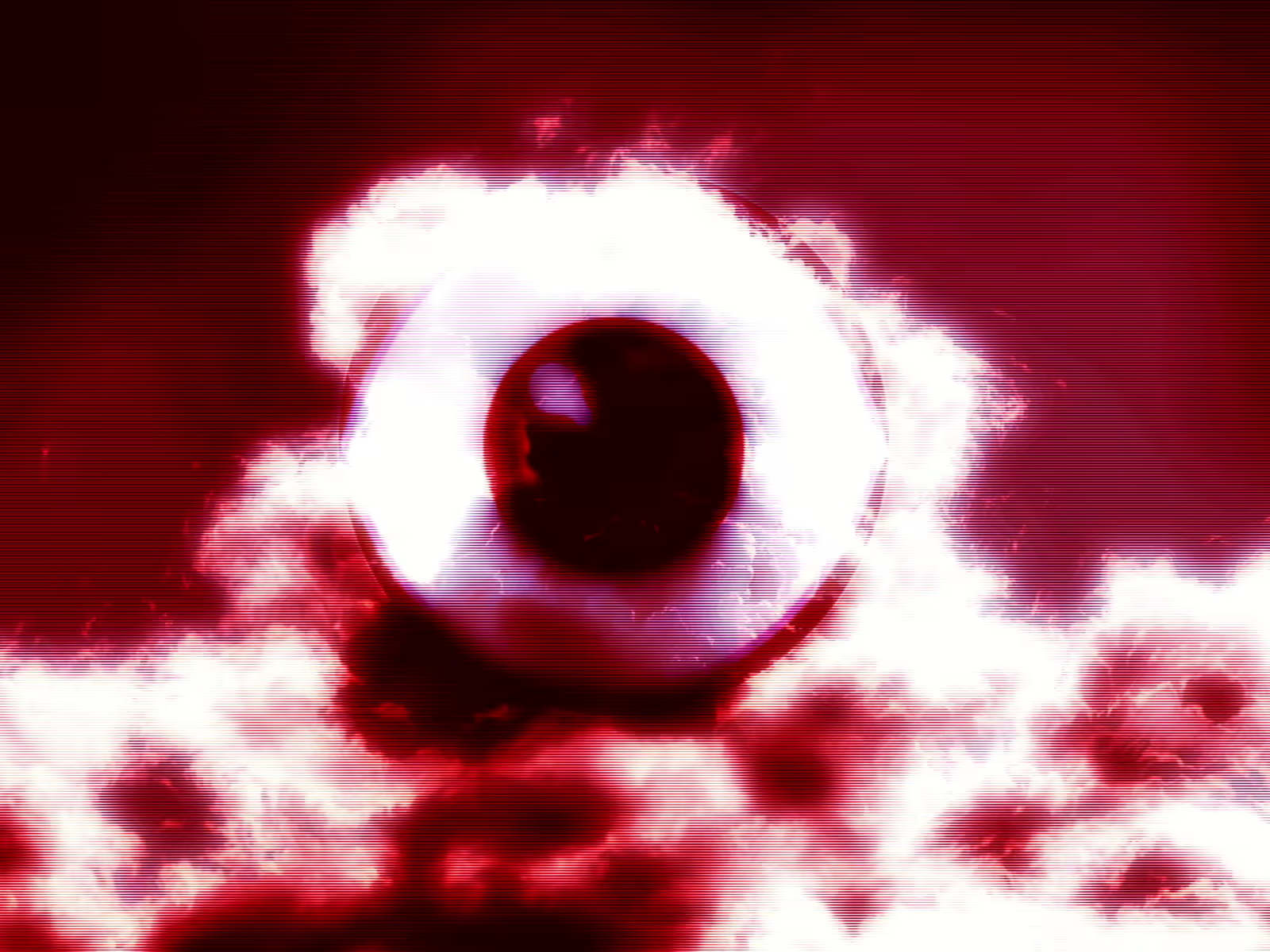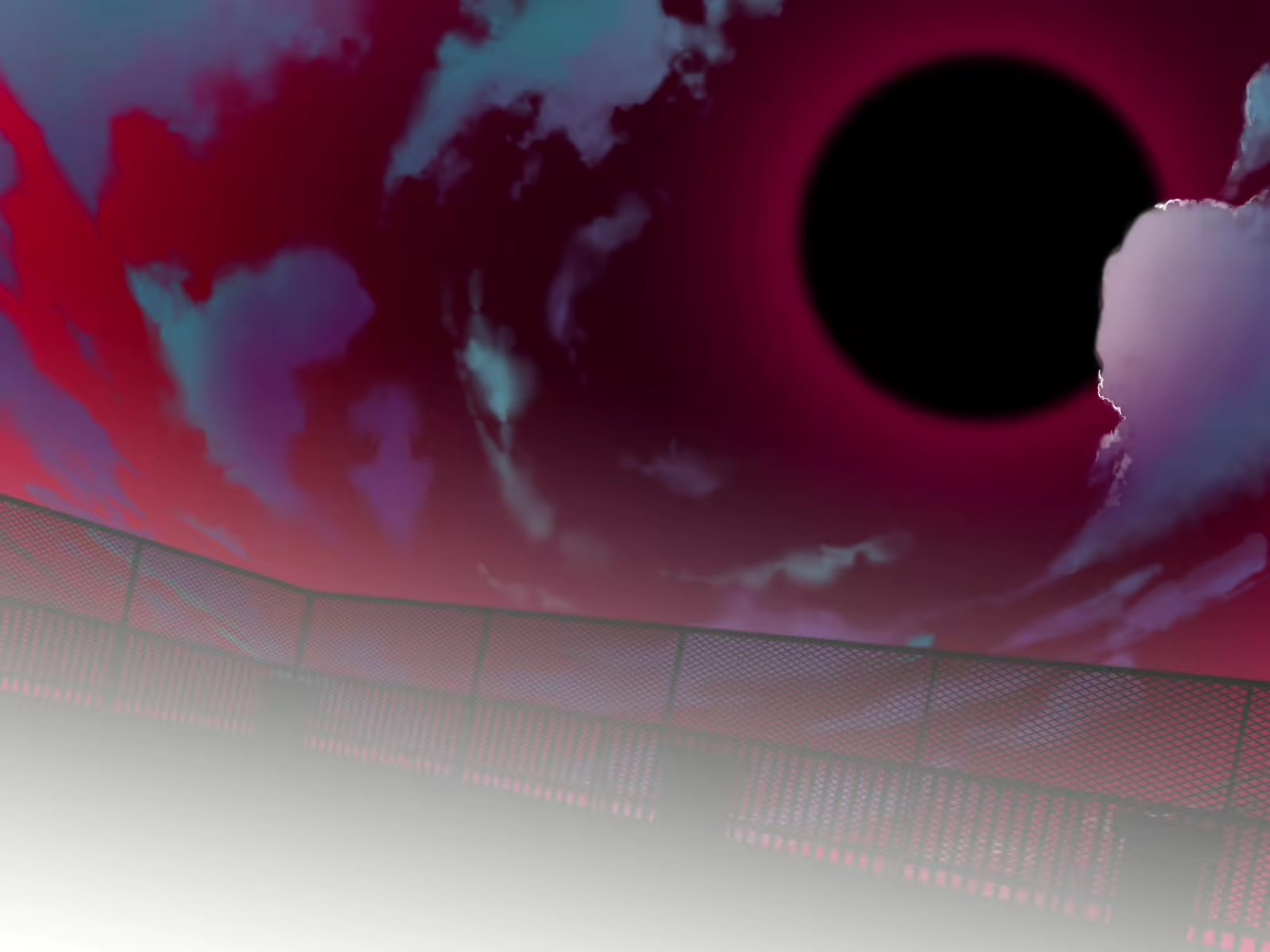
A brief interpretation of Tsui no Sora‘s remake
This post will spoil notable portions of both Tsui no Sora’s Remake and Subahibi.
The fear of the dark is the most basic form of fear. Even if that way of putting things is a little broad, it is at the least true as a matter of structure. Most phobias, even of seemingly concrete things that appear as themselves, are highly concerned with the hidden or shadowy nature of their danger. Arachnophobes will, regardless of their feelings about darkness itself, find themselves able to manifest a legion of spiders in every dark storage room before they turn on the light. Similarly, a hypochondriac will invent a mass of dangerous bacteria in every dark and damp space they have to reach into with their hands. This is altogether to say that darkness is the ur-metaphor of the unknown—and therefore maps rather easily onto the fundamental structure of terror as an anxiety in the face of this same unknown. Since all fears connect to this anxiety, they are reducible to a sensation that is adjacent to the basic fear of the dark.
This connection is not always so literal. Darkness is, physically speaking, a space where human perception fails; darkness is the distinctly spatial form of the unknown. But some anxieties and fears are more conceptual or abstract, like a fear of rejection. And there is no literal darkness corresponding to rejection or failure. However, all ideas and concepts are something we experience in coordination with our physical givenness in the world. The human fear of unknown concepts is not that far off in structure from the fear of the dark; a spatial concept such as darkness matches precisely with the terms that we use to locate anxiety in abstractions; “from the outset in formal philosophy, thinking has been thought of in terms of seeing. … The predominance of sight is so deeply embedded in Greek speech and therefore in our conceptual language that we seldom find any consideration bestowed on it, as though it belonged among things too obvious to be noticed.” (Hannah Arendt) This is why, contrary to purely spatial forms of darkness, some categories of fear are chiefly induced by the temporal ‘darkness’ of the future, or by the socio-ontological ‘darkness’ of otherness. Altogether, darkness is representative of the fundamental nature of human (non-)understanding. As Heidegger puts the matter:
When we talk in an ontically figurative way of the lumen naturale [natural light] in man, we have in mind nothing other than the existential-ontological structure of this entity, that it is in such a way as to be its “there.” To say that it is ‘illuminated’ means that as Being-in-the-world it is cleared in itself, not through any other entity, but in such a way that it is itself the clearing. Only for an entity which is existentially cleared in this way does that which is present-at-hand become accessible in the light or hidden in the dark.
That is, the whole sensation of human being-there in existence is as a source of light that uncovers the world of the known out from the darkness of the unknown. But that darkness is still out there, lurking in everything we fail to “illuminate” with our sense of understanding, and therein fueling the eternal human possibilities of fear, terror, and anxiety.

This is not exactly a review or an essay. My goal is contrary to the critical distance implied by either of those terms. Instead, I want to engage in an exercise of very immediate interpretation whilst in the afterglow of having just played Tsui no Sora (the Remake)—although, afterglow is perhaps too positive-sounding a word. In line with the highly self-indulgent nature of this mission, I am also not necessarily here to explain the bases for my thoughts fully in the manner that I normally try to—or as I am focusing on doing in the book I am busily working on. I want to tightly pack in as many of my thoughts as possible; more for my own reference rather than for the sake of any readers. I apologise for that.
Tsui no Sora and Wonderful Everyday: Discontinuous Existence (Subahibi from here on out) both have equivocal relationships with notions of truth, reality, and objectivity. By way of example, when “Takuji Mamiya” ‘first’ encounters his Nyarlathotep during Subahibi, its immediate phenomenal cause appears to be the loss of light due to a power outage. And the first form it takes is as the zombified corpse of Zakuro Takashima.

It is a very primal moment, when the fear of the dark manifests a confrontation with human alienation from death. (“People have hidden death. The world has hidden death.” – Ayana Otonashi) But what exactly is the Nyarlathotep in such a scene? Where does it reside? In Tsui no Sora, Yasuko Yokoyama comes to believe that Nyarlathotep is located “in the brain” of those who witness it; it is for this reason that she commits suicide, to kill off one vector of the Nyarlathotep’s existence. But this invites questions of the sort of falling trees in forests: if the Nyarlathotep’s existence takes place in the human brain, as a phenomenon of perception within its witnesses, by what standard does it even exist?
With one hand, Tsui no Sora seems to confirm a canonically Lovecraftian explanation for its fiction. Who caused the mass suicide incident at Kita High School? If we take the text literally, the answer is the Outer Gods of the Last Void beyond the Gates of the Silver Key. That is, straightforwardly, the entities of the Lovecraftian universe—particularly Nyarlathotep. But with its other hand, Tsui no Sora also strips this explanation from us. The repeated (seemingly self-indulgent) excursions into epistemological navel-gazing intersect exactly with questioning the validity of this supernatural explanation—and I believe that noticing this intersection is likely to account for many interpretative differences in the reception of this story. I will therefore spend much of what follows explaining this peculiar give-and-take.
A thought experiment that Ayana Otonashi repeats in both Tsui no Sora and Subahibi goes roughly as follows: if a series of human brains were wired together with electrical stimulus that manifested the appearance of a ‘something’ that doesn’t otherwise ‘exist’ in material space, is there any standard for existence used by humans that would not also apply to this appearance? Put in a negative form, how do we tell our own world apart from an artificially generated shared delusion? The point being that the sharedness of reality is the only anchor of that reality that cannot be reduced down to the untrustworthiness of the human brain, which is already susceptible to delusion. As Hannah Arendt explains it, “the reality of what I perceive is guaranteed by its worldly context, which includes others who perceive as I do, on the one hand, and by the working together of my five senses on the other. What since Thomas Aquinas we call common sense, the sensus communis, is a kind of sixth sense needed to keep my five senses together and guarantee that it is the same object that I see, touch, taste, smell, and hear.” The “sixth sense” that connects our five other senses is a communal sense created by the reference point of others. Therefore, Ayana posits the thought experiment of interwired brains in part to highlight the possibility that, if a delusion were to enter into common sense, it would be effectively indistinguishable from reality.
This problem of common sense corresponds rather precisely to the problem of Nyarlathotep as an entity in the story. Why do we as players take the existence of Nyarlathotep and other supernatural entities to be possible, or even likely? It is not merely that we ‘see’ them as an experienced phenomenon within the story. After all, we are given ample reasons to doubt the perspectives of those who ‘see’ Nyarlathotep—from drug use to more deep rooted psychological trouble. What ultimately cements Nyarlathotep in the story is common sense; many different people see Nyarlathotep, many different people independently arrive at an overlapping vocabulary for Nyarlathotep, and many different people experience the same results of Nyarlathotep’s actions. We have no particular reason to regard Nyarlathotep as demonstrably more suspect than the existence of the school itself, or characters such as Takuji Mamiya and Kotomi Wakatsuki.
But this is where the efforts to question issues of fundamental existence start to pay off. Ayana posits that the world exists as the unified pantheistic experience of one soul who experiences a discontinuous existence through the infinite transmission of itself through all lives and perspectives. We don’t have to take this theory too seriously for the moment. But we can nonetheless walk away with certain questions. Is the conclusion that one should draw from the problem of Nyarlathotep not that Nyarlathotep exists because of common sense, but that common sense is itself doubtful in basic arenas beyond Nyarlathotep? In contrast to Tsui no Sora, Subahibi proceeds straightforwardly on the basis of this problematic, by presenting a story that is superficially identical to Tsui no Sora in its key features, but nonetheless ends up revealing that it was exactly these seemingly certain elements of common sense that were unreliable: Kotomi Wakatsuki turns out to be an illusory character, and the other characters who seem to correspond to their role in Tsui no Sora all turn out to be entirely ‘different people’ from how they first appear.
In the final ending of Subahibi, titled Tsui no Sora II, Ayana posits that the seeming consistency between the illusory perspectives of Subahibi’s characters does not suggest reality in the form of common sense, but irreality, once again in the form of the discontinuous existence of one soul. She argues that the consistencies between the world of Subahibi from Chapter 2 onwards, and the corresponding lack of consistency between these Chapters and the first Chapter of the story, suggests the possibility that all of these subsequent Chapters were a dreamworld viewed by one soul from the vantage point of this first Chapter. Moreover, since so many of the incongruencies of Chapter 1 amount to details that connect it to Tsui no Sora’s depiction of events but not Subahibi’s, seemingly wild possibilities such as Subahibi amounting to a dreamworld within Tsui no Sora are left open to interpretation.

The point of bringing this all up is not just to allow for a more speculative take on the timeline of the story to be taken literally. Rather, what Subahibi appends to any reading of Tsui no Sora is an emphasis on the contingency and unreliability of human perspective. We can best see the application of this point to Tsui no Sora through its most seemingly reliable perspectives. Of its five perspective characters, Yukito Minakami and Kotomi Wakatsuki come the closest to never seeing Nyarlathotep. From the position of their two Chapters combined, the incidents at Kita High School still appear to be free of supernatural influence. The overriding motif of their Chapters is the pervasive importance of mood and crowd psychology in dictating human behaviour and human belief. But this can also be read in terms of the importance of common sense in determining effective reality. Yukito is unable to sense the shift in mood, and is therefore late to ‘save’ Kotomi, because he steadfastly insists in trusting only in what seems rationally possible from his attempt at an objective perspective. He is not receptive to the common sense that anchors other students together in a shared reality, and which makes the “end of the world” possible rather than impossible within the terms of this shared common sense. Yukito articulates this in terms of the inherent uncertainty of the future in correspondence with past sensory experience. He chooses to trust in past experience as more likely than inferences made on the basis of a changing communal mood, whereas his classmates trust in the common sense of the changing mood and come to believe in something that was deemed impossible in the past common sense.
If we were to privilege the later perspectives of Tsui no Sora, we would say that Yukito was fooled because he did not encounter Nyarlathotep. But the precise problem is that there is no reason to do so; Tsui no Sora does not, as it may appear superficially, affirm the existence of Nyarlathotep. And neither does it reject its existence by attributing the phenomenon to crowd psychology. The problem is that, as Ayana suggests in her thought experiments, that the common sense relied upon by Yukito and the common sense relied upon by the crowd are structurally equivalent. Hence, the story equivocates between the two.

How this equivocation functions can be grasped by returning to the phenomenal structure of Nyarlathotep. In reference to Takuji’s encounter with Nyarlathotep in Subahibi, Ayana repeats the terms of the Lovecraftian mythos, referring to an encounter with “The Crawling Chaos”—another name for Nyarlathotep in Lovecraft’s fiction.

This form of Nyarlathotep appears as a generalised phenomenon of darkness, intruding into the minds of its victims in response to their fear. This motif is shared with Lovecraft’s version of the character and world: the transcendent entities of Lovecraftian horror are primal fears that lurk in realms of incomprehensibility beyond human understanding. Encountering a Lovecraftian horror untethers the victim from reality, as they attempt to understand something beyond the basic categories of human comprehension and common sense. This is why Lovecraft’s style of gothic horror has been commonly interpreted as a kind of conceptual horror based around the fear of the unknowable (as opposed to merely unknown). Of course, in the case of Lovecraft, there is a diegetic concreteness of these entities, and they cannot be reduced to mere allegories. But the situation may be complicated in Tsui no Sora and Subahibi.

As explored earlier, these works twist the unknowability and primal horror of Nyarlathotep around and suggest the equivalent unknowability and primal horror of human common sense. The appearance of Nyarlathotep in these stories is far from concrete or self-reliant. In the case of Takuji in Subahibi, Nyarlathotep only appears out from the darkness and specifically in response to him witnessing the death of Zakuro. In Heidegger’s system of time, the fear of death is not a simple physiological response: a Dasein (human perspective) who is resolutely and authentically being-toward-death is able to confront the fact that death is always ecstatically projected from future to present as a possibility—that is, they are able to accept the uncertainty of death as an ever-present possibility. By contrast, when a person who otherwise attempts to remain alienated from death is suddenly overwhelmed by the uncertainty of this possibility, it produces a pervasive sensation of dread in the face of death. This is to say that a confrontation with darkness and death comprises a total spatial and temporal encounter with uncertainty about existence. It is a moment where everything is possible and yet nothing is real. The phenomenology of the spreading cult of Kita High School and their encounters with Nyarlathotep are all contextualised by this darkness. The members of the cult, after repeated encounters with death (Ozawa and Zakuro in particular), lock themselves away in a secluded dark space that is utterly disconnected from the common sense of outside society. Within this space, all of the ethical and epistemological mores of society break down into an orgy of desire-seeking—producing a heterogeneous exterior in the style of the thought of Georges Bataille.
In this situation, we must once again ask where Nyarlathotep is located. Is it ‘reality’? Is it the darkness of uncertainty? Is it the human brain? Is it the Last Void? The Tsui no Sora (End Sky)? The equivocation of Tsui no Sora depends on the degree to which an absolute answer to this question is not necessary to establish the facticity of Nyarlathotep as an appearing phenomenon. And neither does Nyarlathotep need to specifically exist or not-exist ‘objectively’ or canonically. Nyarlathotep can be explained as a real eldritch entity that enters into the minds of the students of Kita High School. But it can also be explained as a phenomenon of crowd psychology in the face of darkness and death. The commonality of the ‘delusion’ of Nyarlathotep need not be a delusion at all: it is simply the common sense world shared by the mood of the cult, produced by Takuji’s accidental charisma, which the members perceive in the absence of any other ‘real’ world—which has itself been replaced by death (temporal darkness) and darkness (spatial darkness) in seclusion from society. That is, a kind of collective unconscious. Or, as Ayana suggests, there might be no particular reality at all beyond the dreamworld of the unified soul of existence.

What, then, is the point of this uncertainty, and of this story at all when it is littered with unrealistic non-answers supported by pseudo-philosophical pontification? Tsui no Sora is a famous leading example of what has come to be known as denpa horror. Denpa-kei—referring in this context to those who seem off in their own world of EMP waves—is a subcultural strand connecting art and expression that depicts the outsiders of society. That is, those who cannot connect to the “waves” of mainstream society and conventional common sense. Denpa horror uses forms of terror and anxiety unique to one’s outsider status, and then connects these to the wider logic of horror fiction in general. Not all examples are as equivocal as Tsui no Sora about fundamental concepts such as reality, but the reasons for that equivocation do not quite make sense without considering these outsider themes of denpa fiction.
Tsui no Sora was released in the wake of the 1995 Tokyo subway sarin gas attacks by the doomsday cult Aum Shinrikyou. The Aum attacks provoked fear all across Japanese society, but like many comparable terrorist incidents it also incited tensions between social insiders and outsiders. Aum was attached to otaku culture in a manner comparable to the earlier anti-otaku panic after the crimes of Tsutomu Miyazaki—or in more general terms, comparable to the mass shooting inspired moral panic in the United States during the same decade, or to the reaction against the Japanese left in response to the United Red Army incident of 1972.
The cult in Tsui no Sora has many no doubt intentional parallels to the Aum incident. Yes, its depiction does communicate the horror of how outsiders—how those excluded from society’s common sense by drug use, socioeconomic disadvantage, mental illness, bullying, incest, or exclusion from heteronormative values—are sources of fear insomuch as they cannot be predicted or understood by those on the inside of mass society. However, it also equivocates on this perspective, and depicts the encounter with the darkness of Nyarlathotep as not just understandable, but even justified. It argues that the values of common sense are no more justified than the values of those who are ‘infected’ by Nyarlathotep—at least as a matter of having a claim to a ‘true’ reality. The horror of Tsui no Sora is that everyday existence can turn into a Lovecraftian horror, whether either one was ever real or not. It does not always succeed in telling this story tell, but it nonetheless speaks to something at the core of all counter-culture.

